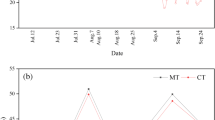Abstract
A nitrogenous controlled release fertilizer (Floranid 32) and a treatment of municipal organic waste compost were tested under two irrigation managements (conventional and ET-adjusted irrigation rates) with the aim of assessing risk of nitrate leaching to the aquifer. A check without N fertilizer was introduced. The experiment was carried out at La Poveda Field Station (30 km SE Madrid, Spain) in alluvial soils with water table depth at 4 m and under maize cropping. The experiment was laid out in a randomized complete block design with three replications, allocating 12 plots to each irrigation management. Although N fertilizer rate (150 kg ha−1) was reduced at half as related to a previous experiment, no difference in grain yields was observed. This result relates to a high content of soil-N. Floranid showed promising results in controlling N-leaching in comparison with urea that exhibited an accelerated rate of N release which finally determines low use of N by the plant and marked NO3 − leaching. Treatment of municipal waste compost showed NO3 − concentrations in the soil water solution of similar values as those of urea at 140 cm. ET-adjusted irrigation showed no drainage during the corn growing season and lower NO3 − concentrations in the soil water solution which could indicate a general lower rate of N solubilization.
Similar content being viewed by others
References
Diez JA (1988) Revisión del método de determinación automatizada de Nitrógeno U.V. oxidable en extractos de suelo. Anal Edafol Agrobiol 47: 1029–1039
Diez JA, Roman R, Cartagena MC, Vallejo A, Bustos A and Caballero R (1994) Controlling nitrate pollution of aquifers by using different controlled release fertilizers in maize crop. Agr Ecos Env 48: 49–56
European Economic Community 1980. Council directive on the quality of water for human consumption. Official J 23 No 80/778 EEC L229: 11–29
Letey J, Bigar JW, Stolzy LH and Ayers RS (1978) Effect of water management on nitrate leaching. In Prat PF (ed) Nat. Conf. of Management of Nitrogen in Irrigated Agriculture. Dept Soil and Environ. Sci. Univ. of California Riverside CA 231-249
Lund LJ (1982) Variations in nitrate and chloride concentrations below selected agricultural fields. Soil Sci Soc Amer J 46: 1062–1066
Nemeth K (1979) The availability of nutrients in the soil as determined by electro ultrafiltration(EUF). Adv Agron 31: 155–187
Nielsen DR, Simmons DS and Bigar JW (1979) Flux of nitrate from an spatially variable field soil. In P.F. Pratt (Ed) Nitrate in effluents from irrigate lands. Rep. to Natl. Sci. Fonndation. Nat. Tech. Information Service, Springfield VA. 487–501
Roman R, Caballero R,Bustos A, Diez JA, Cartagena MC and Vallejo A (1994) Field scale fluxes of water and nutrients under conventional corn cropping practices in Central Spain. I Water Balance Soil Sci Soc Amer J (in review)
Wiklicky L and Nemeth K (1981) Düngungsoptimierum mittels EUF-Bodernuntersuchung bei der Zükerrube. Sonderdruck aus Band 106: 982–998
Author information
Authors and Affiliations
Rights and permissions
About this article
Cite this article
Diez, J.A., Caballero, R., Bustos, A. et al. Control of nitrate pollution by application of controlled release fertilizer (CRF), compost and an optimized irrigation system. Fertilizer Research 43, 191–195 (1995). https://doi.org/10.1007/BF00747701
Issue Date:
DOI: https://doi.org/10.1007/BF00747701




